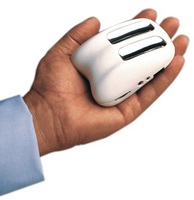 19th Oct 2015
19th Oct 2015
How to Use Biofeedback in Physical Therapy
Biofeedback is a wonderful modality in physical therapy. The ultimate mind/body technique, Biofeedback is used to train people how to improve their health by using and interpreting signals from the body. Biofeedback units provide a way for patients to gain control of certain physical processes that are normally regarded as automatic from the autonomic nervous system. This information has therapeutic applications when used in physical therapy as it helps patients regain movement and function of daily activities.
MyoTrac BioFeedback Unit for Home Use
How Biofeedback works
Biofeedback (or biological feedback) uses an instrument to monitor bodily responses, such as muscle tension or skin temperature, as the person tries to modify their response to stimuli. For example, the monitor might give feedback with a tone that goes higher if the muscles in the face tighten and lower if the muscles relax. Another example would be the monitoring of a patient increases or decreases of temperature in their hands (or feet), such as when treating patients with Raynaud’s Disease.
Increased muscle tension and changed body temperature are two of the body's main responses to stress and strain, the bodies “fight or flight” response. By providing patients with instant and continuous information on these involuntary and unconscious processes in the body using Biofeedback, they can observe and attempt to modify their body's reaction to stress. After a patient has used biofeedback to develop their ability to recognize and reduce tension in their body with physical therapy, the patient will be able to take these skills and apply them when they are under stress in their day to day life.
Uses of Biofeedback in Physical Therapy
- Migraines: Biofeedback has been shown to reduce migraine frequency and severity by 45-60%. When combined with a pain relieving medication, biofeedback’s effectiveness increases to 70%.
- Pelvic Dysfunction: Biofeedback uses electrodes placed on the body (on the perineum and/or the area around the anus) to sense how tense or relaxed the pelvic floor muscles are and display the results on a computer or other device. These cues can help patient’s learn to relax those muscles.
- Paralysis: Biofeedback can be used to help stroke patients regain movement in paralyzed muscles. In a study published in The Journal of Neuroengineering and Rehabilitation, biofeedback improved a patient’s results of gait training, helping gain normal speed, stride, and increase ankle power.
- Chronic Pain: Stress responses and anxiety frequently magnify or cause chronic pain. The pain, of course, results in more anxiety which then creates more pain. By learning to relax, patients learn to limit or avoid the stress response brought on by anxiety limiting its ability to create pain in the body.
- Raynaud’s Disease: A syndrome of the circulatory system which causes the blood vessels to constrict, Biofeedback has been shown to be highly effective in treating Raynaud’s Disease. Research by the Association for Applied Psychophysiology and Biofeedback shows thermal biofeedback is effective in the treatment of primary Raynaud’s Disease, with 80-90% of patients reporting improved circulation and a reduced frequency of symptoms, such as numbness, throbbing and swelling.
Biofeedback is an empowering tool in physical therapy treatment. Biofeedback provides the needed mind/body connection which is sometimes missing in our patient populations. And the most positive effect Biofeedback provides is the tools patient’s learn in the clinic have practical applications and impact in their day to day life, improving their quality of life even after treatment ends.
Popular Biofeedback devices for home and clinical use
| SEMG - MyoTrac Home Trainer | MyoTrac Infiniti Biofeedback Device | GSR 2 Biofeedback Unit |
 |  |






